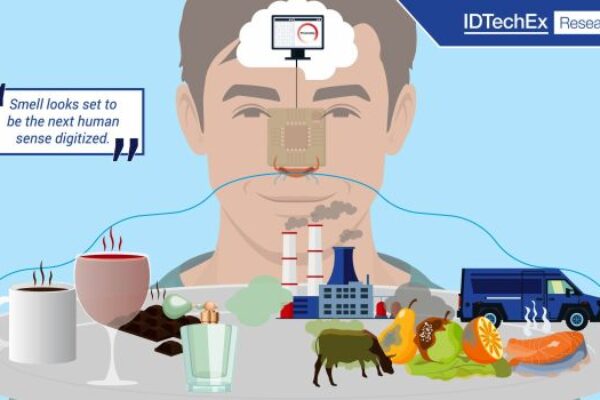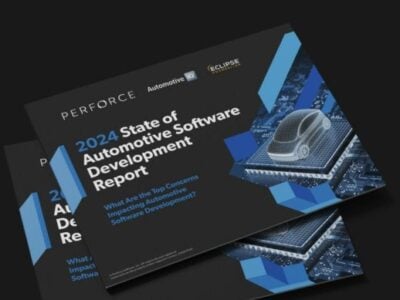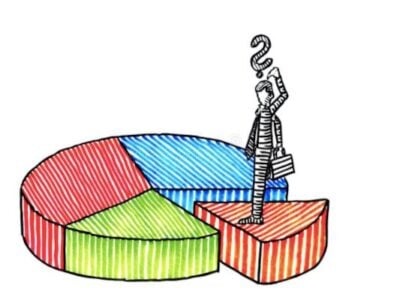
Sensors plus ML promise to digitize sense of smell
The opportunities for digital smell could be vast, says market research firm IDTechEx, but what are they, and what gas sensor technology will enable it? A new report from the firm compares and benchmarks over 15 different gas sensor technologies that could be used within e-nose systems as well as many other applications such as air quality, automotive, and safety.
In the case of e-nose sensing, the latest gas sensor technology is designed to digitize smell by imitating the human nose and brain. Human noses are full of receptors that respond to gas mixtures, and over time the brain learns to recognize a given smell. In the same way that humans are not born able to distinguish roses from lilies, electronic noses also require a period of training.
So-called ‘e-noses’ combine arrays of gas sensors with machine learning algorithms that can identify patterns in response to a specific smell. The capabilities of miniaturized sensors and machine learning software have been growing and have now reached a level of commercial readiness to create a digital smell industry, says the firm.
“Food and drink are obvious sources of smells we care about and a key-use case for e-noses,” says the firm. “For example, the source of an aroma profile, or differences in smell between similar foods, is poorly understood. E-noses offer a solution to better understand what makes our favorite dishes so tempting.”
On the other hand, measuring gases given off by food as it deteriorates or becomes contaminated offers a way to maintain food quality and ensure safety. It could even help tackle food waste issues, with smell data offering an alternative to ‘best before’ dates. At an industrial level, ensuring product consistency and quality control could also utilize smell sensors more broadly, which could threaten the existing supply chain of lab-bench equipment used in this area.
Commercial devices suitable for integration into smart-home goods and factories are just now emerging to monitor food and drink. Some manufacturers are beginning to add gas sensors into white goods, and others will need to follow to compete in the smart home market going forward, says the firm.
Beyond quantifying smell, many new e-nose technologies are targeting more sensitive and selective measurements of air quality than existing gas sensors. It is these capabilities that have seen them begin to be adopted into smoke detectors, including alarms in the home and sensors distributed outside for wildfire monitoring.
“There is growing interest in air quality and its impacts on our health,” says the firm, “particularly long exposure to low concentrations will also create demand for e-noses. The success of this use-case in the smart city and home sectors will arguably rely on effective marketing by OEMs, with this being a major barrier to mass-market adoption in the medium term.”
The use of arrays in e-noses creates an opportunity for multiple types of gas sensor technology. The data from well-known sensors such as metal-oxide, electrochemical and infrared, photoacoustic, and others can all be used by software looking to quantify gas mixtures. At the same time, advanced materials can form ultra-miniaturized sensors with the potential for integration into smartphones and wearables.
Some challenges for e-nose technology remain. For example, the use of lower-cost and poor sensitivity commoditized sensors and higher-value software places a significant burden on training the artificial intelligence required. However, the inherently higher-performance hardware for e-noses, such as printed carbon nanotubes, are not yet manufacturable at scale and are still seeking a ‘killer app’ and high-volume orders.
Furthermore, says the firm, to date, the infrastructure to train e-noses and share the data is limited. While images have been simplified into an RGB format, there is not yet an equivalent for smell. This challenge has been identified by some, such as Aryballe, but before the digital smell industry can reach its full potential, there needs to be more standardization.
The digitization of smell would be an exciting addition to the sensing capabilities of consumer electronics, says the firm. The technology has historically had a reputation for being over-hyped, but off-the-shelf devices represent the real process made by the sector. This has largely been driven by innovations in the fundamental gas sensor technology required, in parallel with the maturity of machine learning software.
For more, see the report, “Gas Sensors 2022-2032: Technology, Opportunities, Players, and Forecasts.”
 If you enjoyed this article, you will like the following ones: don't miss them by subscribing to :
eeNews on Google News
If you enjoyed this article, you will like the following ones: don't miss them by subscribing to :
eeNews on Google News




